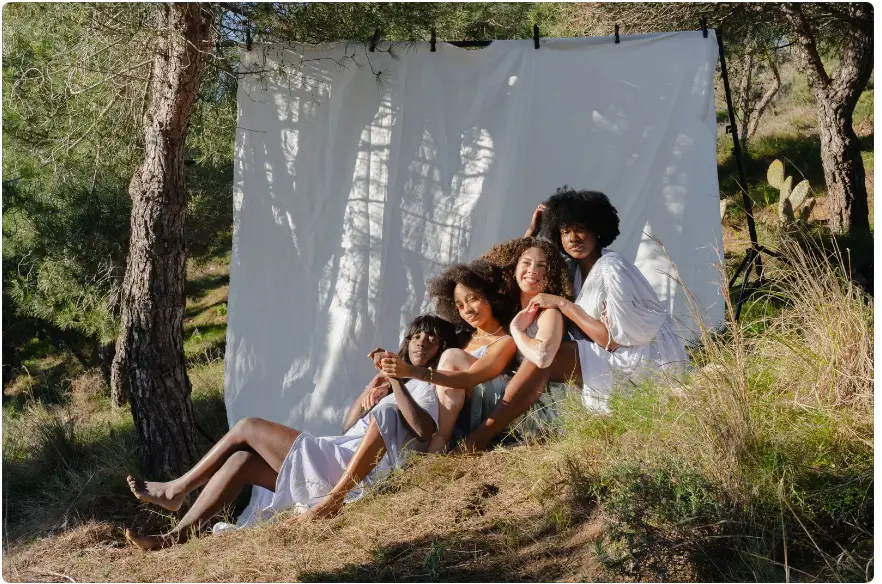In the spotlight-filled realm of reality TV, a headshot isn’t just a photo—it’s your ticket to stardom. It’s the first impression, the visual handshake, the one shot to stand out in a sea of hopeful faces. But what happens when that all-important moment gets captured not by a professional, but by a charlatan?
From over-the-top retouching disasters to the unethical dealings of photographers who should know better, we’ve compiled a list of ten headshot horror stories that are bound to leave you wide-eyed. Whether you’re preparing for your own photo session or just love a good cautionary tale, brace yourself for some shocking revelations. Trust us, after reading these tales, you’ll be triple-checking your photographer’s references!
Contents
1. The “Photoshop Disaster” Story:
The world of photography has always been intertwined with the magic of editing. Yet, sometimes, this magic morphs into an unrecognizable disaster. Enter Carla’s story. Radiating with anticipation, she had approached her photoshoot day as a milestone towards her dream. But the results were far from what she had imagined. Instead of receiving polished but authentic headshots, she found herself staring at a digital caricature of her own face.
The photographer’s overzealous use of Photoshop left Carla with comically enlarged eyes that seemed to pop out of their sockets, a nose so refined it looked more like a sketch, and a face so thinned out that it defied human anatomy. Her natural freckles, the very essence of her character, were wiped away, replaced by an eerily smooth complexion. Instead of enhancing her features, the editing robbed Carla of her individuality and authenticity.
Beyond the initial shock and disappointment, the episode raised questions about the photographer’s ethical boundaries. Was it his place to redefine someone’s identity? Did he not understand the implications for someone trying to break into the world of reality TV, where authenticity is paramount? Carla’s dream headshot became a stark reminder that in the quest for ‘perfection’, one could lose the very essence of what makes them unique.
2. The “Never-Received Photos” Tale:
The age-old adage “A picture is worth a thousand words” took a bitter twist for Mike. Ready to embark on his journey into the limelight, he meticulously chose a photographer who showcased impressive portfolios and glowing testimonials. The day was picture-perfect (pun intended); Mike posed with an array of expressions and outfits, all under the expert guidance of the photographer. Hours went by, filled with flashes, adjustments, and words of encouragement. It felt right, and Mike was convinced he had nailed it.
Fast forward a few weeks, the anticipation reached its peak. Each day, Mike eagerly checked his mailbox, expecting to find a package of his professionally taken headshots. But days turned into weeks, and weeks into months. Every attempt to contact the photographer was met with deafening silence. The office was perpetually closed, emails bounced back, and calls? They were always greeted with the frustratingly familiar robotic voice stating the number was “out of service.”
The reality began to sink in. Not only was Mike robbed of his time and money, but also of the opportunity those headshots might have brought him. The trust he placed in the photographer was shattered.
The tale serves as a chilling reminder: in the age of digital convenience, faceless transactions can sometimes lead to heartbreaking deceit. It underscores the necessity of thorough background checks, signed agreements, and perhaps, an instinctive gut feeling when choosing who to trust with your dreams.
3. The “Unwelcome Advances” Incident:
Emma, bright-eyed and hopeful, was about to experience a side of the industry no one ever warns you about. She’d chosen her photographer based on raving reviews and a portfolio that screamed professionalism. But as the saying goes, not everything that glitters is gold.
Right from the outset, things felt off. There were the subtle comments that started off as compliments but slowly tiptoed across the line of propriety. Remarks about her physique, suggestions of “more flattering” outfits that were increasingly revealing, and lingering touches under the guise of ‘adjustments’. The air grew heavy with unease.
The pinnacle of discomfort came when, between shots, the photographer leaned in too close, his whispers coated in ill intent. Emma felt trapped. Every fiber of her being screamed to flee, but the weight of her ambition and the fear of being branded ‘difficult’ held her in place.
It’s a tragic reality that many face in the world of glitz and glamour. Emma’s ordeal underscores the imperative need for clear boundaries, the importance of trusting one’s instincts, and, above all, recognizing that no ambition is worth compromising one’s safety.
4. The “Bait and Switch” Scenario:
Jake, an aspiring reality TV star, understood that a captivating headshot was his passport to opportunities. So, when he saw an advertisement featuring a seasoned photographer with decades of experience, he jumped at the chance.
Arriving at the studio, the first clue came in the form of outdated equipment. Then, the man behind the camera – youthful, fumbling, and clearly inexperienced. Jake’s heart sank as he realized he had fallen prey to a classic bait and switch. Instead of the promised veteran photographer, he was stuck with a novice whose expertise seemed limited to taking casual phone snaps.
Throughout the session, Jake witnessed a comedy of errors: incorrect lighting that cast unflattering shadows, poor guidance on poses, and a general air of confusion. The resulting photos were nothing short of amateurish, looking more like awkward candid shots than professional headshots.
Jake’s experience is a cautionary tale about the pitfalls of not doing due diligence. It reminds us that while promotional materials might dazzle, it’s imperative to scratch beneath the surface, verify credentials, and perhaps even insist on meeting the photographer in person before committing.
5. The “Lost All Data” Nightmare:
For Sarah, the day of her photoshoot was magical. The light was just right, her outfits looked spectacular, and she felt on top of the world, striking pose after pose with confidence. As she left the studio, she felt certain that among the numerous shots taken, there would be the one perfect headshot that could propel her into the reality TV spotlight.
Imagine the gut-wrenching feeling when, weeks later, the photographer contacted her with a voice laden with guilt. Due to a catastrophic hard drive failure, all her photos – every single frame captured during those golden hours – were lost. The absence of a backup system compounded the calamity.
Sarah’s anguish was palpable. It wasn’t just about the lost time, effort, and money, but the lost opportunity and the emotional weight of the memories attached to that day. Her story serves as a stark warning about the perils of placing blind faith in technology and underscores the vital importance of photographers investing in reliable backup systems to safeguard their work and their clients’ dreams.
6. The “Hidden Fees” Experience:
Rahul’s quest for the perfect headshot seemed to be smooth sailing initially. He was quoted a competitive price, the photographer was reputed, and everything appeared transparent. The shoot went off without a hitch, and Rahul eagerly awaited his final images.
However, the pleasant experience soon soured. Upon receiving his invoice, Rahul was shocked to find a slew of additional charges. Retouching, which he assumed was part of the package, carried a hefty fee. Each print was priced exorbitantly, and to add insult to injury, there was a mysterious charge for ‘extra time’ spent during the shoot.
Feeling cheated and exploited, Rahul confronted the photographer, leading to a bitter dispute. The experience left a sour taste and served as a distressing lesson on the importance of clear communication and written agreements. Rahul’s tale is a wake-up call for all budding stars, emphasizing the need to clarify every detail, ensure no hidden costs, and have everything documented to prevent unexpected surprises.
7. The “Public Humiliation” Event:
In the age of social media, our images can speak volumes, sometimes even more than we intend them to. Clara, bubbling with enthusiasm, had her headshots taken, only to face rejection from several casting calls. Disappointed but resilient, she decided to move on. But what she hadn’t prepared for was the public mockery that awaited her.
One idle evening, as she scrolled through her social media feeds, she stumbled upon her own rejected headshots, displayed on the photographer’s page as glaring examples of “what not to do.” Accompanying captions ridiculed her choices of outfits, makeup, and even her expressions.
The humiliation was immeasurable. Here was a personal, intimate experience, taken without her consent and showcased to the world in a demeaning light. It wasn’t just an invasion of her privacy; it was a direct attack on her self-worth.
Clara’s story highlights the dangers of the digital age, where unethical actions can amplify harm on a global scale. It’s a stark reminder about the importance of privacy agreements and respecting personal boundaries, emphasizing that professionalism must extend beyond the lens and into our online interactions.
8. The “Stolen Identity” Occurrence:
Raj, like many, saw his headshot as a personal brand – a depiction of who he is, what he brings to the table. So, the shock was profound when a friend traveling abroad sent him a snapshot of an advertisement featuring Raj’s face promoting a product he had never even heard of.
The betrayal cut deep. His trusted photographer had not just broken their contractual agreement but had also sold Raj’s identity for profit. Without consent, without knowledge, his image was being used, and there was no telling how extensively or for how long.
Beyond the financial implications and potential missed opportunities, this incident raised unsettling questions about identity in the digital age. Who controls our likeness once it’s captured in pixels? How can we safeguard our personal brand in a world where images can be disseminated with a click?
Raj’s unsettling journey underscores the need for water-tight contracts that explicitly outline image usage rights. It’s a call for vigilance, reinforcing the need for clear communication and legal safeguards to protect one’s identity in an increasingly interconnected world.
9. The “Highly Inappropriate Background” Instance:
Photography, at its core, is an art of storytelling. A good photograph can convey emotions, narrate tales, and build connections. But in Mia’s case, her headshot told a story she had never intended to tell. Excited about the promise of a modern, urban backdrop for her headshot, Mia was horrified when she received the final edits.
Instead of the sophisticated cityscapes she envisioned, her face had been awkwardly superimposed onto a series of bizarre and questionable backgrounds. From kitschy tropical beach scenes to wildly inappropriate party scenarios, it was clear that the photographer’s idea of “urban” was a far cry from the norm.
More than just a mismatch in creative vision, the incident highlighted the photographer’s lack of professional judgment. The inappropriate backdrops not only rendered the headshots useless for professional purposes but also painted Mia in a light that was not representative of her personality or her brand.
Mia’s misadventure underlines the critical importance of clear communication between the subject and the photographer. It’s a testament to the fact that while creativity should be encouraged, it should never come at the expense of the client’s vision or reputation.
10. The “Left in the Lurch” Episode:
Time, as they say, is money. For Derek, this couldn’t be truer. Having scheduled and paid for a professional headshot session months in advance, he had meticulously planned his day, taking time off work, preparing outfits, and even getting professional grooming.
But as the clock ticked on the day of the shoot, the photographer was nowhere to be seen. Calls went unanswered, texts were met with silence, and Derek found himself stranded, grappling with the realization that he might have been duped.
Beyond the financial loss, the episode brought with it an avalanche of frustrations. Rescheduling, finding a new photographer on short notice, and the sheer emotional drain of feeling cheated made the ordeal all the more painful.
Derek’s unfortunate experience serves as a cautionary tale about the importance of vetting professionals, even in seemingly straightforward transactions. It’s a potent reminder of the unpredictability of human engagements and the necessity to always have a contingency plan, especially when one’s professional future is at stake.
Conclusion
So that’s our list of 10 horror stories. Have you ever had a bad experience with with a photographer or someone who is creating your casting video application? If so, we’d love to hear from you so that we can share your experience and advice to our other readers.
Also, if you’d like to learn more about what to look for when booking your reality show casting headshots, we’ve created a full guide on that.





